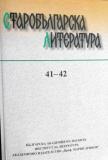Зограф Василие и стенописът "Чудото с Василие, син Агриков" в Боянската църква
The Artist Basil and the Fresco
„The Miracle with Basil, the Son of Agrikos” in the Boyana Church
Author(s): Kazimir PopkonstantinovSubject(s): Cultural history
Published by: Институт за литература - БАН
Summary/Abstract: THE ARTIST BASIL AND THE FRESCO „THE MIRACLE WITH BASIL THE SON OF AGRIKOS” IN THE BOYANA CHURCH KAZIMIR POPKONSTANTINOV (VELIKO TĂRNOVO) (Summary) The scholarly interest towards the Boyana church and the “Boyana master” has been recently revived thanks to the inscription (“азъ василие писахъ”) and the drawings found by the restorers in the wall area around the church entrance. My work with the newly found inscription bearing the name of the artist Basil as well as with the rest of the epigraphic material made it possible to fill a considerable gap in the history of the Boyana church. Furthermore, some of the scenes painted in the narthex have provoked a new interpretation since they seem to have been related to the work and style of that artist called Basil. One of them belongs to the life cycle of St Nicholas. The Life of St Nicholas includes a miracle that happened in Myra when, during the service, the Arabs attacked the church and captured the entire congregation including a certain youth called Basil. All were carried off to Crete as prisoners. Basil, on the account of his youth and beauty, was appointed by the Emir his cup-bearer. Basil’s parents did not know anything about the fate of their son and were very desperate. Their neighbors advised them to pray passionately to St Nicholas and indeed, the saint rescued their son from the Arabs. The scene with the happy return of Basil to his family cannot be found in any of the known Byzantine fresco cycles of St Nicholas’ Life. Yet, though rear, it is depicted in several churches in Serbia and Republic of Macedonia. The artists in Boyana, Psača (R Macedonia) and Ramaća (Serbia) did not relay on a definite Byzantine iconography. According to N. P. Ševčenko, it seems rather that all of them turned to West European versions or employed their own imagination. The scene in the Boyana church does not find parallels and direct analogies in the rest of the known fresco cycles, representing that miracle of St Nicholas. It appears as a peculiar nuance and accent in the iconographic program of the Boyana church and can be distinguished not only with its artistic characteristics and composition, but also with the specifics of the personages. The most impressive is the main figure in that scene – Basil rescued from the Saracens. It can be only speculated whether that episode was somehow related to the personal life of the artist Basil and thus, he approached it in a specific, unique manner in the frescoes.
Journal: Старобългарска литература
- Issue Year: 2009
- Issue No: 41-42
- Page Range: 383-401
- Page Count: 19
- Language: Bulgarian
- Content File-PDF

